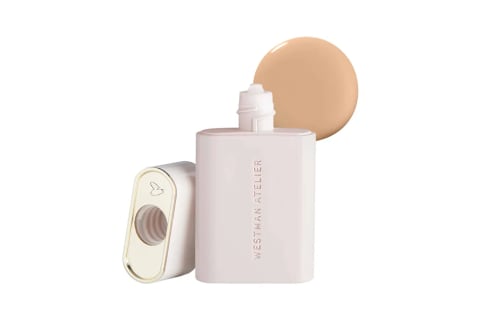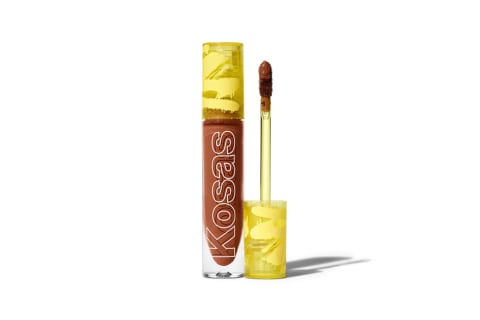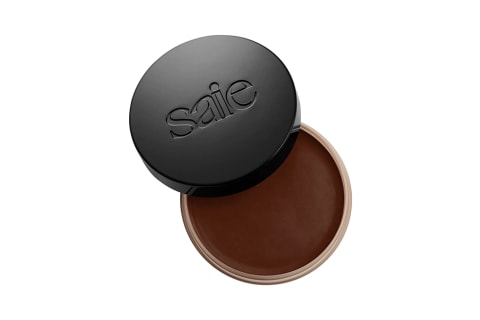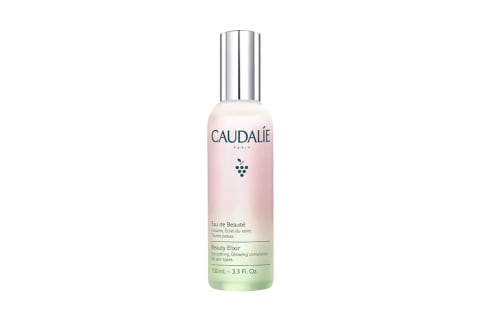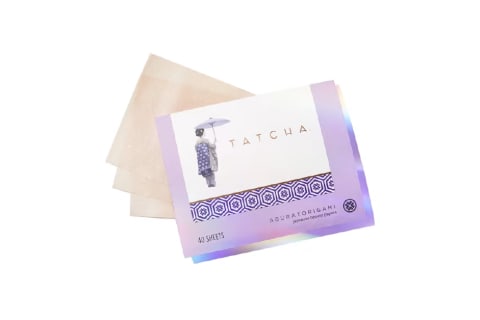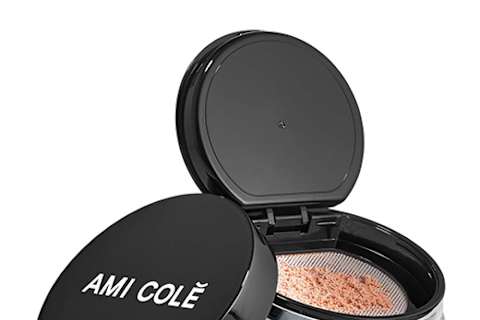Advertisement
Why Does My Makeup Look Cakey? 5 Reasons + Fixes


Makeup can be a useful tool for enhancing your natural beauty, making you feel more confident, experimenting, or simply expressing yourself. Makeup is so versatile, and really there's no right or wrong way to apply it.
However, a common complaint that many people have when it comes to makeup is that their complexion ends up looking "cakey." If you've ever felt this way, or you just want to prevent a cakey base in general, then keep reading. We asked experts exactly how to skip a cakey finish and why it happens in the first place, so let's get into it.
What does "cakey" makeup even mean?
So, what does "cakey" makeup really look like? Generally speaking, cakey makeup means the foundation, concealer, or whatever base product you're using looks heavy, uneven, splotchy, or it's noticeably creasing.
This kind of look happens most often when there are layers upon layers of product on the skin—think primer, foundation, concealer, bronzer, powder, and the like. While you may want to use all of these products for one full-glam look, layering them directly upon each other can lead to a cakey finish if you're not strategic.
When this happens, your makeup look may begin to slip and slide, and it likely won't photograph as smooth or luminous. To follow, what habits and techniques are making your makeup look cakey and how to fix it.
Why it happens & how to avoid it
There are so many reasons your makeup isn't turning out the way you'd hoped, so we're going to walk through each potential problem and offer a quick solution to fix it:
The problem: Skin isn't prepped
"From my experience, if the skin is super dry, any foundation or powder will catch on dry skin and cause it to look unblended, heavy or splotchy," Emmy Award–winning makeup artist Alexandra French tells mbg.
This is why it's so essential to tend to your skin before any makeup touches it. Even if you did your basic skin care routine earlier in the day, it's a better idea to cleanse the skin and start over than layer on more products.
The solution: Cleanse and prep
"I usually start skin prep with a cotton round and a micellar water, which is super gentle for any skin type, and clean the face with that," French says. "This helps clean the skin and does a gentle exfoliation, removing dead skin."
You can opt for a gentle facial cleanser as well if that's more your speed. If you want to go above and beyond, consider using ice globes, dunking your face in a bowl of ice water, or doing a cool compress with a chilly towel beforehand. This will help depuff the skin and make your face look even more sculpted.
The problem: You're applying too much product
Applying too much product is the leading cause of cakey makeup, makeup artist Alexandria Gilleo tells mbg. "Applying too much product can build up and cause the skin to pill or become uneven, blotchy, and textured."
Too much product can mean too much foundation, concealer, or powder. While you may think a full-glam look requires a hefty layer of makeup, that's not always the case.
See, foundation is designed to be a buildable medium, meaning you can add more in places you need it without having to go all-in on the first go-around.
The solution: Start slow and build
Liquid foundation is the most popular medium, so picture that one in your mind. Rather than squirting the foundation directly onto your face or a brush, pump it onto the back of your hand. Once it's there, you have greater control over how much actually goes on your face.
Start by placing a light dot on each section of your face toward the center (the cheeks, chin, and forehead), or lightly dab your brush in the foundation puddle. Then, blend onto your face and down your neck.
If you see redness peeking through or you want more coverage on a blemish, then you can go in and add more after the product has been set for a minute or so. Remember that concealer also works wonders for spot coverage, so you don't have to have a perfect canvas with just foundation.
The problem: You're mixing textures incorrectly
"It's important to read the labels and make sure you are wearing the right foundation, cream, concealer, etc., for your skin type and for the desired application you're wanting to achieve," Gilleo says.
Read: If you want a dewy, luminous look, then stick to products marketed as such. If you need to limit oil and shine on the skin, then look for mattifying products rather than glow-inducing ones.
The solution: Use similar bases
"If you have oily skin, using a more mattifying foundation will be best," French explains. So rather than pack loads of powder on top of a dewy-skin foundation to achieve a mattified T-zone, start with a foundation that corresponds to your skin type and add shine afterward via highlighter.
The goal here is to use as little product as possible, so keeping your end goal in mind from the second you start prepping your skin is essential.
The problem: You're using expired products
If you've been using the same base products forever but find that they've recently been looking off, your products might be past their due date. "Expired products can make the formulas really funky, and it's definitely something you do not want to put on your face," Gilleo says.
The solution: Check your products
"There's usually a triangle on the package of products with a little number in them; the number represents the number of months the product is good for," Gilleo explains.
If you find yourself unable to use up the product by its expiration date, consider buying a smaller size to prevent wasting the product.
The problem: You're touching up your makeup too many times
"In the summertime, it can be so hot, a lot of the makeup will melt off and there's only so many times it can be touched up," French says. Rather than add more concealer or more powder to your look, it might be a better idea to start fresh.
"When I'm on set, I am a huge fan of removing the makeup completely during lunch and reapplying it to give it a fresh look," she explains. This is important for those looking to take a makeup look from day to night, as it might not always make the full 12 hours (and that's OK).
The solution: Schedule in time to redo your look
Say you're on vacation and you have a full day planned out. Rather than leave a quick five minutes time to touch up your look, schedule a decent 20- to 30-minute period to redo your look for the evening, just in case it needs more love.
This way, you'll go into the night feeling more confident, and you'll be able to be present in the moment rather than running through anxious thoughts about your makeup's subpar finish in your head.
The problem: You're layering too many products
Some people can plop bronzer on top of foundation and blush on top of that, but for others, that's a cakey recipe.
The solution: Underpaint your makeup
For those especially prone to a cakey finish, you might want to look into the underpainting method. "There's an old-school technique where you apply contour after your skin care first and then spot treat with concealer," French describes.
Basically what you're doing here is applying a single layer of makeup while still checking all of the product boxes. You can even try applying your bronzer and blush as a base, then going in with foundation after. Just try to experiment with your order of operations and see how many layers you actually need at the end of the day.
Best base products
How to fix it (if you've done it already)
If you've already applied your makeup and it looks cakey, there are ways to fix it—so don't fret:
Melt it with setting spray
Gilleo opts for a setting spray and makeup sponge dual approach. First, mist the face with your favorite setting spray, and then take a slightly damp beauty blender and dab lightly on the cakey areas.
Use blotting sheets
After that, she goes in with blotting sheets. Only dab these on the areas you find to be the creakiest, which will most likely be in the T-Zone.
You can keep these sheets on hand for touch-ups throughout the day, as well as a tool to manage extra shine.
Continue blending
You don't want to declare your makeup cakey too soon. If you barely blended your foundation, especially if it's a thicker product, simply keep blending. Sometimes it takes longer than you think, but the smooth finish will be worth the time investment.
If you're using a brush, swap to a makeup sponge or even clean fingers. You may just need to shake up your method to see the best results. Plus, if you applied too much makeup to your brush in the first place, then immediately swap tools to avoid layering on even more product.
Remove makeup from areas that easily crease
"I am also a fan of taking a makeup wipe and wiping off the makeup under the eyes and smile lines, the first place where it will start to cake," French suggests. You can do this with micellar water on a cotton round or a damp tissue.
"Add a tiny bit of moisturizer and reapply the concealer," she adds. This way, you'll only have one layer of makeup on those problematic areas, which will lower the chances of it creasing.
Switch brushes or sponges
As mentioned above, a brush or sponge with loads of product on it simply won't do much for you once your look is already cakey. Instead, grab a fresh tool and continue blending as you normally would. If you're using a sponge, still get it slightly damp rather than go in dry.
This way, your fresh tool will absorb the excess product while blending at the same time.
Best touch-up products
FAQ
How do I make my makeup look smooth?
The key to a smooth finish is applying makeup to well-hydrated skin and not using too much product. Always start small and build the coverage as you see fit. Let your makeup set in between layers.
What does it mean when makeup look cakey?
Generally, "cakey" makeup means the foundation, concealer, or whatever base product one is using looks heavy, uneven, splotchy, or it's noticeably creasing.
Why does my makeup look dry?
If your makeup looks dry, it could be due to a lack of skin prep, a mattifying foundation that isn't right for your skin type, or expired makeup.
The takeaway
While there's no wrong way to play with makeup, a cakey finish is not often a desirable look. To help prevent this, remember to always start with less product than you might need and build it as you go. Do your best to use as few products as possible, and limit your powder to a light dusting if needed. Last but not least, don't forget to find a foundation product that aligns with your skin type—here are 13 of the best clean options on the market if you need a new favorite.
